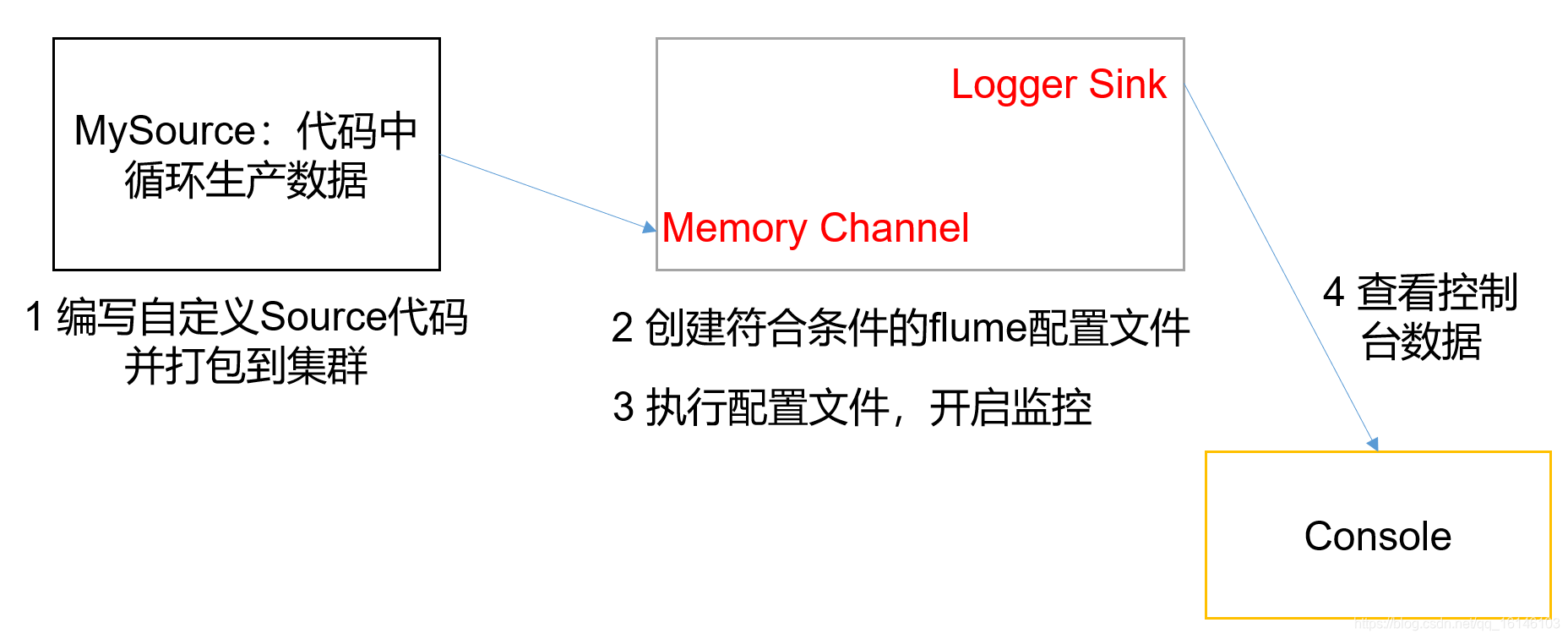这篇文章我们讲解的是如何自定义Source。
1. Source的简单介绍
Source是负责接收数据到Flume Agent的组件。Source组件可以处理各种类型、各种格式的日志数据,包括avro、thrift、exec、jms、spooling directory、netcat、sequence generator、syslog、http、legacy。官方提供的source类型已经很多,但是有时候并不能满足实际开发当中的需求,此时我们就需要根据实际需求自定义某些source。
官方也提供了自定义source的接口:
https://flume.apache.org/FlumeDeveloperGuide.html#source
根据官方说明自定义MySource需要继承AbstractSource类并实现Configurable和PollableSource接口。
实现相应方法:
getBackOffSleepIncrement()//暂不用
getMaxBackOffSleepInterval()//暂不用
configure(Context context)//初始化context(读取配置文件内容)
process()//获取数据封装成event并写入channel,这个方法将被循环调用。
使用场景:读取MySQL数据或者其他文件系统。
2. 需求/分析
使用flume接收数据,并给每条数据添加前缀,输出到控制台。前缀可从flume配置文件中配置。


3. 编码
3.1 导入pom依赖
<build>
<plugins>
<plugin>
<groupId>org.apache.maven.plugins</groupId>
<artifactId>maven-compiler-plugin</artifactId>
<configuration>
<source>8</source>
<target>8</target>
</configuration>
</plugin>
</plugins>
</build>
<dependencies>
<dependency>
<groupId>org.apache.flume</groupId>
<artifactId>flume-ng-core</artifactId>
<version>1.7.0</version>
</dependency>
</dependencies>
3.2 编写代码
package com.buwenbuhuo;
import org.apache.flume.Context;
import org.apache.flume.EventDeliveryException;
import org.apache.flume.PollableSource;
import org.apache.flume.conf.Configurable;
import org.apache.flume.event.SimpleEvent;
import org.apache.flume.source.AbstractSource;
import java.util.HashMap;
import java.util.Map;
/**
* @author 卜温不火
* @create 2020-05-04 16:00
* com.buwenbuhuo - the name of the target package where the new class or interface will be created.
* flumeplugins0504 - the name of the current project.
*/
public class MySource extends AbstractSource implements Configurable, PollableSource {
//定义需要从配置中读取的字段
//两条数据之间的间隔
private long delay;
private String field;
public Status process() throws EventDeliveryException {
try {
Map<String, String> header = new HashMap<>();
SimpleEvent event = new SimpleEvent();
//拿到数据
for (int i = 0; i < 5; i++) {
event.setHeaders(header);
event.setBody((field + i).getBytes());
getChannelProcessor().processEvent(event);
Thread.sleep(delay);
}
} catch (Exception e) {
return Status.BACKOFF;
}
return Status.READY;
}
public long getBackOffSleepIncrement() {
return 0;
}
public long getMaxBackOffSleepInterval() {
return 0;
}
public void configure(Context context) {
delay = context.getLong("delay", 2000l);
field = context.getString("field", "buwenbuhuo");
}
}
4. 测试
- 1 打包上传
将写好的代码打包,并放到flume的lib目录(/opt/module/flume/lib)下。


- 2. 配置文件
[bigdata@hadoop002 job]$ cp flume-netcat-logger.conf flume-mysource-logger.conf
[bigdata@hadoop002 job]$ vim flume-mysource-logger.conf
# Name the components on this agent
a1.sources = r1
a1.sinks = k1
a1.channels = c1
# Describe/configure the source
a1.sources.r1.type = com.buwenbuhuo.MySource
a1.sources.r1.delay = 2000
a1.sources.r1.field = buwenbuhuo
# Describe the sink
a1.sinks.k1.type = logger
# Use a channel which buffers events in memory
a1.channels.c1.type = memory
a1.channels.c1.capacity = 1000
a1.channels.c1.transactionCapacity = 100
# Bind the source and sink to the channel
a1.sources.r1.channels = c1
a1.sinks.k1.channel = c1
- 3. 开启任务
[bigdata@hadoop002 flume]$ [bigdata@hadoop002 flume]$ bin/flume-ng agent -c conf/ -f job/flume-mysource-logger.conf -n a1 -Dflume.root.logger=INFO,console
- 4. 结果展示
展示的结果如预期一样,两秒一次

本次的分享就到这里了,

^ _ ^ ❤️ ❤️ ❤️
码字不易,大家的支持就是我坚持下去的动力。点赞后不要忘了关注我哦!